The Test rig Market is estimated to be valued at USD 5.4 billion in 2025 and is projected to reach USD 12.1 billion by 2035, registering a compound annual growth rate (CAGR) of 8.4% over the forecast period.
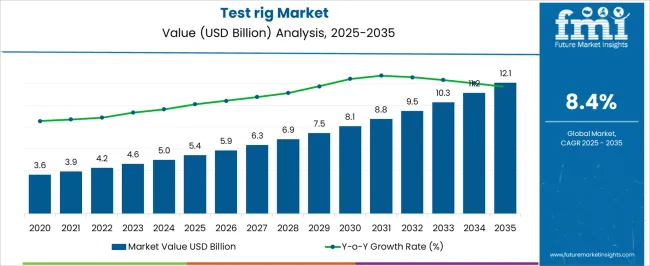
| Metric | Value |
|---|---|
| Test rig Market Estimated Value in (2025 E) | USD 5.4 billion |
| Test rig Market Forecast Value in (2035 F) | USD 12.1 billion |
| Forecast CAGR (2025 to 2035) | 8.4% |
The Test Rig market is witnessing steady growth due to the increasing demand for precise and reliable testing solutions across multiple industries. The current market scenario reflects a preference for advanced systems capable of simulating real-world operational conditions for components, machinery, and materials. Growth is being driven by the need for improved product reliability, compliance with industry standards, and reduced downtime through predictive maintenance.
Investments in automation, manufacturing modernization, and quality assurance initiatives are further supporting market expansion. The ability to integrate digital controls, real-time monitoring, and adaptive load simulation into test rigs has enhanced their appeal across various industrial applications. As manufacturers seek efficiency gains, durability improvements, and process optimization, the market is expected to witness continued adoption of versatile test rigs that can adapt to evolving product specifications.
Additionally, increased emphasis on reducing operational costs and ensuring safety compliance is reinforcing the importance of test rigs in development and production processes Future growth opportunities are anticipated in modular and software-driven systems that provide enhanced flexibility and data-driven insights for industrial operations.
The test rig market is segmented by operation, product type, vertical, and geographic regions. By operation, test rig market is divided into Hydraulic and Hydrostatic. In terms of product type, test rig market is classified into General Purpose Test Rig and Mechanical Test Equipment. Based on vertical, test rig market is segmented into Manufacturing, Industrial, Automotive, and Others. Regionally, the test rig industry is classified into North America, Latin America, Western Europe, Eastern Europe, Balkan & Baltic Countries, Russia & Belarus, Central Asia, East Asia, South Asia & Pacific, and the Middle East & Africa.
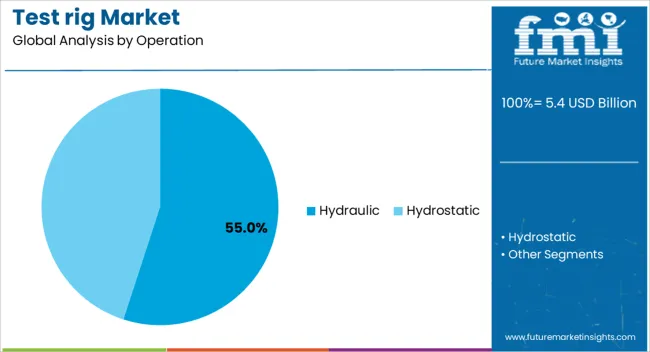
The Hydraulic operation segment is projected to hold 55.00% of the Test Rig market revenue share in 2025, making it the leading operation type. This leadership is being attributed to the high efficiency and precise force control offered by hydraulic systems, which are ideal for simulating dynamic loads and stress conditions in a wide range of testing scenarios. Hydraulic systems are widely adopted due to their ability to handle heavy-duty applications and maintain stability under continuous operation.
The growth of this segment has been reinforced by industrial sectors that demand high repeatability, safety, and robustness in testing processes. The scalability of hydraulic test rigs and their compatibility with automation technologies has further accelerated adoption.
In addition, these systems provide versatility in load application and can be integrated with sensors for real-time performance evaluation The strong performance of hydraulic rigs in quality assurance and product validation has solidified their market position, while ongoing improvements in energy efficiency and digital controls are expected to drive continued expansion of this segment.
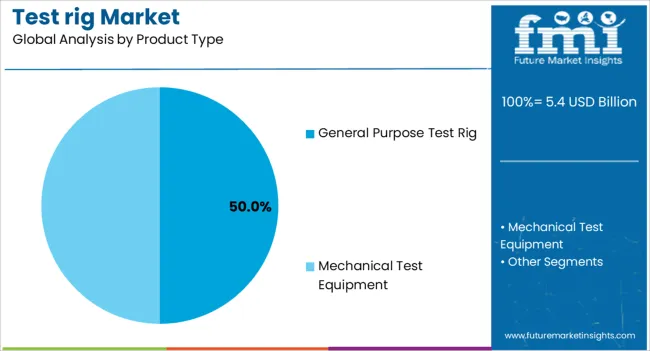
The General Purpose Test Rig product type is anticipated to account for 50.00% of the Test Rig market revenue in 2025, establishing it as the leading product type. This dominance is being driven by the versatility of these rigs to perform multiple types of tests across different components and assemblies, reducing the need for multiple specialized rigs. General purpose test rigs are preferred due to their cost-effectiveness, adaptability to various operational conditions, and ability to accommodate both hydraulic and mechanical configurations.
The segment has benefited from rising demand in manufacturing and research facilities where flexible testing solutions are critical. Their design allows easy integration with digital monitoring systems and automated data acquisition, which enhances testing accuracy and efficiency.
Furthermore, the widespread applicability of general purpose rigs across industries has accelerated adoption, as organizations prioritize resource optimization and long-term operational efficiency The capability to adapt to new testing standards and evolving industrial requirements ensures that this product type maintains a leadership position in the market.
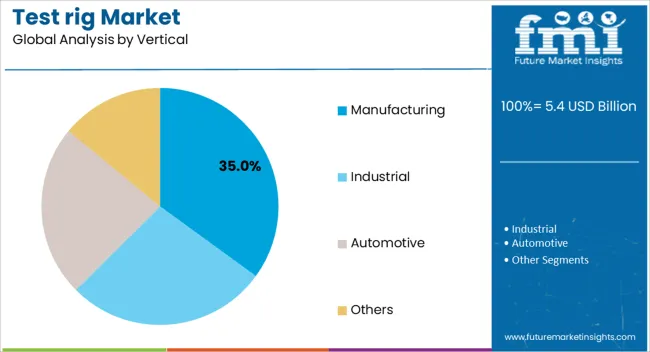
The Manufacturing vertical segment is expected to hold 35.00% of the Test Rig market revenue share in 2025, making it the leading end-use industry. This leadership has been attributed to the high demand for component and equipment testing to ensure product quality, operational reliability, and compliance with stringent industrial standards. Manufacturing facilities are increasingly adopting test rigs to perform fatigue testing, load simulation, and performance evaluation to reduce production errors and optimize processes.
The growth of this segment has been further supported by modernization efforts, including the implementation of Industry 4.0 practices and automation technologies, which require precise testing solutions for machinery and assembly lines. The integration of digital control and real-time monitoring into test rigs has enhanced their effectiveness in detecting defects and improving product performance.
As manufacturers continue to emphasize operational efficiency, safety compliance, and product reliability, the demand for versatile and high-performance test rigs is expected to maintain the leadership of the Manufacturing vertical in the market Additionally, the increasing focus on reducing warranty claims and ensuring long-term equipment durability reinforces the adoption of test rigs in this segment.
A test rig is a piece of apparatus, or a system, which involves several pieces of equipment that works together. A test rig is specifically designed for the purpose of testing any apparatus. Companies which are manufacturing test rig are offering a wide range of products in electrical testing instruments for multiple purposes.
A test rig is also used for safety purposes or testing of products in industries, such as manufacturing and industrial. A test rig provides enhanced productivity and quality. A test rig also plays a primary role in detecting faults and production of electronic equipment. The cost of a test rig is comparatively lower than that of other testing equipment.
A test rig saves the labor time and reduce technical errors. A test rig are powerful tools for measuring the intensity of electricity. Test rig have the ability of conducting tests of variety of electronic instruments, such as high voltage test, impulse winding tests, power analyzer, and many more.
Test rig are also useful in laboratories that work with multiple functions, such as for repairing services and workmanships.
Test rigs are being used widely in the manufacturing industry as it play an important role in the industry for multiple purposes before processing. Test rigs are also used for physical characterization of intermediate products during manufacturing and for finished works. Moreover, the growing demand for electrical equipment products is also creating potential growth opportunities for test rig market.
In addition, the growing manufacturing industry in Asia Pacific, especially in China, India, and Japan is creating potential opportunities for the growth of test rig0020market.
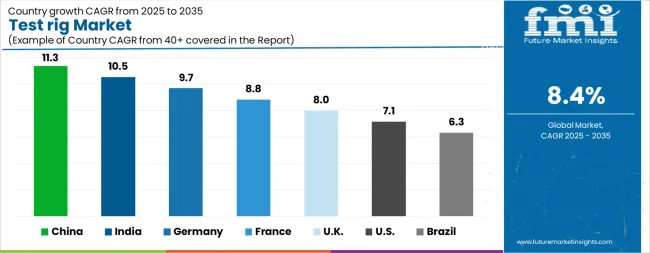
| Country | CAGR |
|---|---|
| China | 11.3% |
| India | 10.5% |
| Germany | 9.7% |
| France | 8.8% |
| UK | 8.0% |
| USA | 7.1% |
| Brazil | 6.3% |
The Test rig Market is expected to register a CAGR of 8.4% during the forecast period, exhibiting varied country level momentum. China leads with the highest CAGR of 11.3%, followed by India at 10.5%. Developed markets such as Germany, France, and the UK continue to expand steadily, while the USA is likely to grow at consistent rates. Brazil posts the lowest CAGR at 6.3%, yet still underscores a broadly positive trajectory for the global Test rig Market. In 2024, Germany held a dominant revenue in the Western Europe market and is expected to grow with a CAGR of 9.7%. The USA Test rig Market is estimated to be valued at USD 2.0 billion in 2025 and is anticipated to reach a valuation of USD 4.0 billion by 2035. Sales are projected to rise at a CAGR of 7.1% over the forecast period between 2025 and 2035. While Japan and South Korea markets are estimated to be valued at USD 280.6 million and USD 154.7 million respectively in 2025.
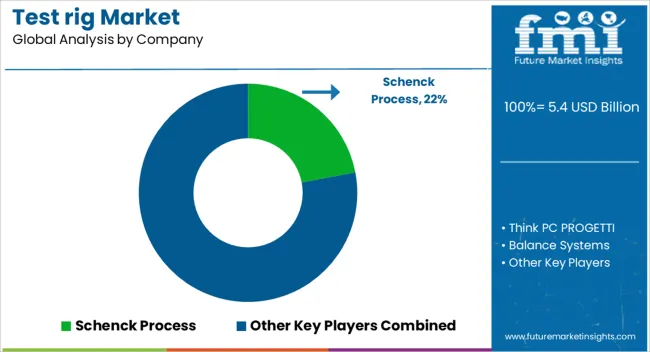
| Item | Value |
|---|---|
| Quantitative Units | USD 5.4 Billion |
| Operation | Hydraulic and Hydrostatic |
| Product Type | General Purpose Test Rig and Mechanical Test Equipment |
| Vertical | Manufacturing, Industrial, Automotive, and Others |
| Regions Covered | North America, Europe, Asia-Pacific, Latin America, Middle East & Africa |
| Country Covered | United States, Canada, Germany, France, United Kingdom, China, Japan, India, Brazil, South Africa |
| Key Companies Profiled | Schenck Process, Think PC PROGETTI, Balance Systems, Schaeffler Technologies, MAHR, ENERPAC, Horiba, Ltd., and AVL |
The global test rig market is estimated to be valued at USD 5.4 billion in 2025.
The market size for the test rig market is projected to reach USD 12.1 billion by 2035.
The test rig market is expected to grow at a 8.4% CAGR between 2025 and 2035.
The key product types in test rig market are hydraulic and hydrostatic.
In terms of product type, general purpose test rig segment to command 50.0% share in the test rig market in 2025.






Our Research Products

The "Full Research Suite" delivers actionable market intel, deep dives on markets or technologies, so clients act faster, cut risk, and unlock growth.

The Leaderboard benchmarks and ranks top vendors, classifying them as Established Leaders, Leading Challengers, or Disruptors & Challengers.

Locates where complements amplify value and substitutes erode it, forecasting net impact by horizon

We deliver granular, decision-grade intel: market sizing, 5-year forecasts, pricing, adoption, usage, revenue, and operational KPIs—plus competitor tracking, regulation, and value chains—across 60 countries broadly.

Spot the shifts before they hit your P&L. We track inflection points, adoption curves, pricing moves, and ecosystem plays to show where demand is heading, why it is changing, and what to do next across high-growth markets and disruptive tech

Real-time reads of user behavior. We track shifting priorities, perceptions of today’s and next-gen services, and provider experience, then pace how fast tech moves from trial to adoption, blending buyer, consumer, and channel inputs with social signals (#WhySwitch, #UX).

Partner with our analyst team to build a custom report designed around your business priorities. From analysing market trends to assessing competitors or crafting bespoke datasets, we tailor insights to your needs.
Supplier Intelligence
Discovery & Profiling
Capacity & Footprint
Performance & Risk
Compliance & Governance
Commercial Readiness
Who Supplies Whom
Scorecards & Shortlists
Playbooks & Docs
Category Intelligence
Definition & Scope
Demand & Use Cases
Cost Drivers
Market Structure
Supply Chain Map
Trade & Policy
Operating Norms
Deliverables
Buyer Intelligence
Account Basics
Spend & Scope
Procurement Model
Vendor Requirements
Terms & Policies
Entry Strategy
Pain Points & Triggers
Outputs
Pricing Analysis
Benchmarks
Trends
Should-Cost
Indexation
Landed Cost
Commercial Terms
Deliverables
Brand Analysis
Positioning & Value Prop
Share & Presence
Customer Evidence
Go-to-Market
Digital & Reputation
Compliance & Trust
KPIs & Gaps
Outputs
Full Research Suite comprises of:
Market outlook & trends analysis
Interviews & case studies
Strategic recommendations
Vendor profiles & capabilities analysis
5-year forecasts
8 regions and 60+ country-level data splits
Market segment data splits
12 months of continuous data updates
DELIVERED AS:
PDF EXCEL ONLINE
Irrigation testing kit Market
Test and Measurement Equipment Market Size and Share Forecast Outlook 2025 to 2035
Testosterone Test Market Size and Share Forecast Outlook 2025 to 2035
Test and Measurement Sensors Market Size and Share Forecast Outlook 2025 to 2035
Testing, Inspection & Certification Market Growth – Trends & Forecast 2025 to 2035
Testosterone Booster Industry Analysis by Component, Source, Distribution Channels and Regions 2025 to 2035
Testosterone Injectable Market
Test Tube Market
Testliner Market
Testicular Cancer Treatment Market
Intestinal Health Pet Dietary Supplement Market Size and Share Forecast Outlook 2025 to 2035
Intestinal Pseudo-Obstruction Treatment Market - Trends, Growth & Forecast 2025 to 2035
Intestinal Fistula Treatment Market Growth - Demand & Innovations 2025 to 2035
5G Testing Market Size and Share Forecast Outlook 2025 to 2035
AB Testing Software Market Size and Share Forecast Outlook 2025 to 2035
RF Test Equipment Market Size and Share Forecast Outlook 2025 to 2035
5G Testing Equipment Market Analysis - Size, Growth, and Forecast 2025 to 2035
5G Tester Market Growth – Trends & Forecast 2019-2027
RF Tester Market Growth – Trends & Forecast 2019-2027
V2X Test Scenario Editor Market Size and Share Forecast Outlook 2025 to 2035

Thank you!
You will receive an email from our Business Development Manager. Please be sure to check your SPAM/JUNK folder too.
Chat With
MaRIA